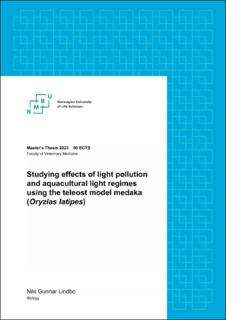| dc.description.abstract | Light is the main cue in synchronizing daily circadian rhythm in most animals, in addition to synchronizing the perception of the year for some species. Due to the steady increase of light pollution around the world, and especially near water bodies, this study aims to investigate the effects of different light regimes. Those regimes include light pollution and the continuous light regime used in aquaculture, mainly to increase growth and delay sexual maturation, is also studied.
Firstly, light pollution levels were measured in Oslo’s main river, and the harbor area. I found that urban light pollution is severe in some places and can reach relatively deep as I detected it at 5 meters depth in the fjord. These results suggest that aquatic animals may be exposed to light pollution in the Oslo area and thus the effects should be studied.
I then investigated in a laboratory setup the effect of light pollution on the teleost model Japanese medaka (Oryzias latipes). In addition to the continuous light regime was also studied. I found several effects of the altered light regimes. The reproductive cycle was found to be desynchronized for both light regimes. The fish’s behavior was also found to be altered. Additionally, fish development was found to be affected with promoted growth and altered brain and heart morphology. The artificial light regimes were also found to affect neurochemistry and the gene expression of one pituitary gene. A clear noradrenergic response was found, with the control fish having higher noradrenergic activity. Fish exposed to light pollution had a higher serotonergic brain activity. The pituitary gonadotropin lhb was found to be decreased in the continuous light regime.
All together these results demonstrate that light pollution and continuous light clearly affect the fish, having welfare implications for aquaculture production, and suggesting that light pollution indeed affects wild fish. | |
